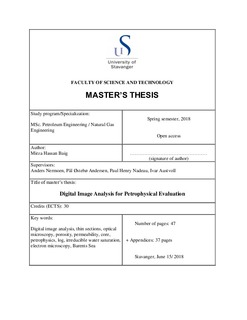| dc.description.abstract | Economic feasibility of any field development largely depends upon its reservoir storage and flow capacity. Porosity, saturation and permeability are important parameters to determine the type and volume of hydrocarbons in place and to estimate recoverable reserves. They are also key parameters in planning, modelling and development of a reservoir.
The porosity and saturation of the reservoir can be determined with reasonable certainty through interpretation of petrophysical logs or through analysis of physical core samples. Permeability evaluation is challenging, because the definition and the scale of this measurement varies across its sources. Well logs provide an empirically derived absolute value, cores provide both scalar (Kair) and vector (Kv, Kh, vertical and horizontal) permeabilities, while the reservoir volume investigated by a well test is quite large as compared to logs or cores. Hence, porosity, saturation and permeability are often compared between its sources, and calibrated as needed. While logs based interpretation is a fast interpretation technique, getting core results can take significant time. Also, not all wells are cored, or sometimes core samples are too small to carry out the analysis, leading to a missing link between core-log integration. To improve some of the inaccuracies and limitations, ‘digital image analysis’ on core or on drill cuttings ‘thin sections’ can be a useful technique in estimating reservoir properties. Digital image analysis can provide porosity, pore size distribution, flow path tortuosity (permeability), irreducible water saturation and mineralogy of the samples. Pore space area and perimeter is also determined and can be used in studying chemical reactions in the pore wall area for improved oil recovery.
This research work aims to develop novel automated digital image analysis methods for Petrophysical Evaluation, and thus overcomes some of the limitations with regards to objectivity and repeatability of traditional manual techniques. To analyze porosity of thin section images, a threshold value on pixels intensity histogram is required to separate pores response from the matrix. A set of rules have been developed to remove human subjectivity in selecting this threshold value. Correlations have been applied for permeability and tortuosity evaluation to understand reservoir flow potential.
Petrographic thin section samples of reservoir rocks from 7128/6-1 well in the Barents Sea are studied. The thin section images are digitalized and analyzed using MatLab functions. Petrophysical properties, namely porosity, permeability and irreducible water saturation are quantified. In addition, some features of the pore space are quantified, including area, perimeter, major & minor axis of the pore area and orientation of the pores. The results from digital image analysis are compared against results from conventional core analysis to establish validity and limitations of thin section image interpretation technique. | nb_NO |
